7 Ways To Ask Family Or Friends For Help With Mental Health

7 Ways To Ask Family Or Friends For Help With Mental Health Woman struggling with mental health. It can be challenging to ask friends and family for help with your mental health, but it is an essential step towards getting the support you need. Here are seven ways you can reach out to your loved ones for help: Start the conversation: Sometimes, just starting the conversation can be the hardest part. You can begin by saying something like, “I’m going through a tough time, and I need to talk to someone.” You can also write a letter or send an email if you find it easier to express yourself in writing. Be specific: It’s helpful to be clear about the type of support you need. Whether it’s someone to listen to you, help you with practical tasks, or accompany you to appointments, it’s essential to articulate what you’re looking for. Choose the right person: Think about who you feel comfortable talking to and who is likely to be supportive. It could be a close friend, family member, or someone you trust, like a teacher or counselor. Be honest: It’s essential to be honest about your mental health struggles and how you’re feeling. It can be scary to open up, but your loved ones cannot help you if they don’t know what’s going on. Ask for a specific time to talk: You can ask your loved one for a specific time to talk, so they can give you their undivided attention. You can also ask them to put aside their phone or other distractions during the conversation. Thank them for their support: It’s essential to acknowledge and thank your loved ones for their help. Let them know how much it means to you that they’re there for you. Seek professional help: While your loved ones can provide valuable support, it’s essential to seek professional help from a therapist or counselor. You can ask your loved ones to help you find a mental health professional or accompany you to appointments. Remember, it’s okay to ask for help. Mental health struggles are common, and many people have been in your shoes. By reaching out to your loved ones, you’re taking an important step towards getting the support you need.
Why Time With Friends Is Essential For Your Mental Health

Why Time with Friends is Essential for your Mental Health Young ladies having fun Spending time with friends can be an incredibly positive experience that can have a profound effect on our mental health. It is a natural human need to have social connections, and these connections are crucial to our well-being. When we are around friends, we can feel a sense of belonging and support that can help us feel better about ourselves and the world around us. Here are some reasons why time with friends is essential for your mental health: Social support: Spending time with friends can provide a valuable source of social support. When we are going through a difficult time, having friends who we can talk to and confide in can be incredibly helpful. Our friends can offer us advice, empathy, and encouragement, all of which can help us feel more supported and less alone. Stress relief: Spending time with friends can be an excellent way to relieve stress. Laughter is a powerful medicine, and spending time with people who make us laugh can be incredibly therapeutic. Even if we are just venting about our problems, having someone to listen can be a great relief. Being around friends can help us forget our worries and feel more relaxed and carefree. Improved self-esteem: Being around friends who accept and appreciate us can help us feel better about ourselves. When we are around people who value us for who we are, we are more likely to feel good about ourselves and our abilities. This positive feedback can be a powerful motivator to help us achieve our goals and become the best version of ourselves. Increased sense of belonging: Humans are social creatures, and we have a natural need to feel like we belong. Spending time with friends who share our interests and values can help us feel like we are part of a community. This sense of belonging can help us feel more connected to the world around us and less isolated. Cognitive stimulation: Spending time with friends can also provide cognitive stimulation. Engaging in stimulating conversations and activities can help keep our brains sharp and alert. We can learn new things, gain new perspectives, and expand our knowledge when we spend time with friends who challenge us intellectually. Better mental health outcomes: Research has shown that people who have strong social support networks are more likely to experience better mental health outcomes. They are less likely to experience depression, anxiety, and other mental health issues. Spending time with friends can be a powerful tool for preventing and managing mental health problems. In conclusion, spending time with friends is essential for our mental health. It can provide us with social support, stress relief, improved self-esteem, a sense of belonging, cognitive stimulation, and better mental health outcomes. If you are feeling stressed, anxious, or lonely, reach out to a friend and spend some quality time together. You will likely find that the benefits are profound and long-lasting.
How Much Water Do You Really Need When You Hit The Gym?
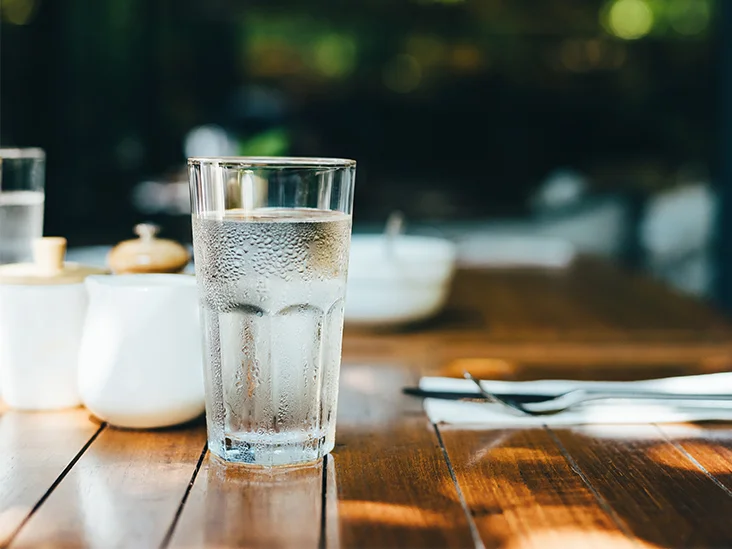
How much water do you really need when you hit the gym? Cold water on the table. Proper hydration is essential for optimal performance and recovery during exercise, and this is particularly true when it comes to hitting the gym. But how much water do you really need when you’re working out? The answer to this question depends on a variety of factors, including the intensity and duration of your workout, your body size and composition, and the environmental conditions in which you are exercising. However, a general rule of thumb is to drink about 17-20 ounces of water two to three hours before exercising, and then another 8 ounces of water 20-30 minutes before your workout. During your workout, you should aim to drink about 7-10 ounces of water every 10-20 minutes, depending on your individual needs and the intensity of your exercise. If you’re exercising for longer than an hour, you may want to consider a sports drink that contains electrolytes to help replace the sodium and other minerals lost through sweat. After your workout, it’s important to continue hydrating to help replace fluids lost during exercise. Aim to drink at least 16-24 ounces of water for every pound of body weight lost during your workout. You can also incorporate foods and beverages that are high in water content, such as fruits, vegetables, and soups, into your post-workout routine. One important consideration when it comes to hydration during exercise is the risk of dehydration. Dehydration can lead to a range of negative effects, including decreased performance, muscle cramps, and even heat exhaustion or heat stroke in extreme cases. In order to prevent dehydration, it’s important to pay attention to your body’s thirst signals and to drink fluids regularly throughout your workout. Another consideration is the risk of overhydration, or hyponatremia, which can occur when you drink too much water without replacing electrolytes lost through sweat. Symptoms of hyponatremia include headache, nausea, confusion, and in severe cases, seizures or coma. To prevent overhydration, it’s important to drink fluids in moderation and to choose sports drinks or other beverages that contain electrolytes when exercising for extended periods of time. In addition to drinking enough water, it’s also important to pay attention to the timing of your fluid intake. Drinking too much water immediately before or during exercise can lead to discomfort and interfere with your performance, while failing to drink enough water can lead to dehydration and impaired performance. One strategy to help ensure proper hydration during exercise is to create a hydration plan based on your individual needs and preferences. This plan should take into account factors such as your body size and composition, the intensity and duration of your workouts, and the environmental conditions in which you are exercising. To create a hydration plan, start by assessing your individual fluid needs. This can be done by calculating your sweat rate, or the amount of fluid you lose through sweat during exercise. To calculate your sweat rate, weigh yourself before and after a workout, and subtract the post-workout weight from the pre-workout weight to determine how much fluid you lost. Once you know your sweat rate, you can use this information to develop a hydration plan that will help you replace fluids lost during exercise. For example, if you lose 1 pound of fluid during a 1-hour workout, you may need to drink 16-20 ounces of water or a sports drink every hour to maintain proper hydration. In addition to developing a hydration plan, it’s also important to pay attention to your body’s thirst signals and to adjust your fluid intake as needed. If you feel thirsty during your workout, take a break to drink fluids and rest. If you experience symptoms of dehydration or overhydration, such as dizziness, confusion, or nausea, stop exercising and seek medical attention. In conclusion, proper hydration is essential for optimal performance and recovery during exercise, particularly when it comes
Seniors And Strength Training: Why It’s Never Too Late To Start
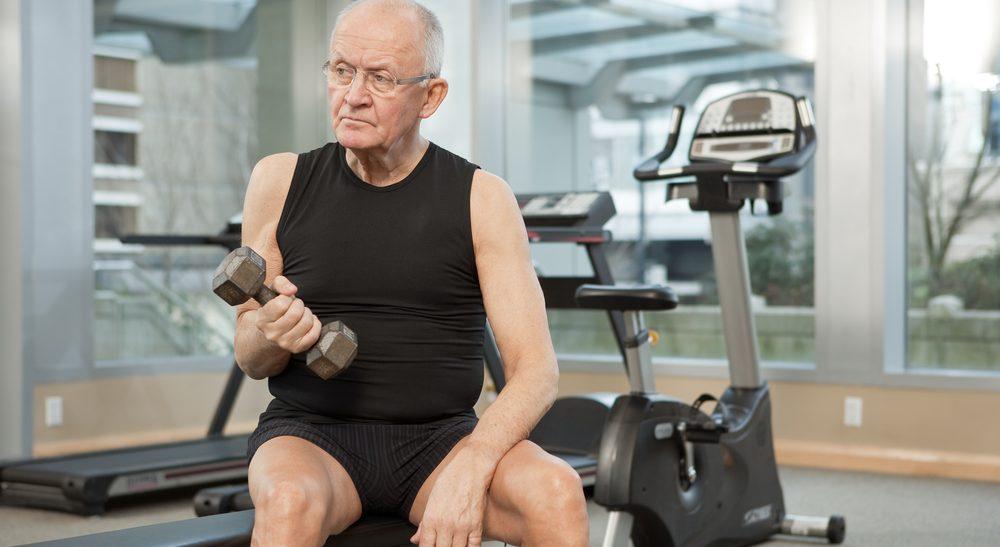
Seniors And Strength training: Why It’s Never Too Tate Old man lifting weights Strength training is typically associated with young people and athletes, but it is actually beneficial for people of all ages, including seniors. In fact, strength training is particularly important for older adults, as it can help prevent age-related declines in muscle mass, bone density, and overall physical function. Despite its benefits, many seniors are hesitant to start strength training due to concerns about safety, fear of injury, or simply feeling intimidated by the gym environment. However, with the proper guidance and support, seniors can safely and effectively incorporate strength training into their fitness routine. One of the key benefits of strength training for seniors is the preservation and improvement of muscle mass. As we age, we naturally lose muscle mass and strength, a process known as sarcopenia. This can lead to a decrease in overall physical function, as well as an increased risk of falls and fractures. By engaging in regular strength training, seniors can slow or even reverse this process, improving their strength, balance, and coordination. Strength training can also help improve bone density, reducing the risk of osteoporosis and fractures. As we age, our bones become weaker and more brittle, making us more susceptible to injury. However, resistance training has been shown to stimulate bone growth, leading to stronger and more resilient bones. In addition to its physical benefits, strength training can also have positive effects on mental health and overall quality of life. Regular exercise has been linked to improved cognitive function, reduced risk of depression and anxiety, and better sleep. For seniors, these benefits can be particularly important in maintaining independence and a high quality of life. So, if you’re a senior and considering starting a strength training program, what do you need to know? First and foremost, it’s important to consult with your doctor before starting any new exercise routine, especially if you have any pre-existing medical conditions. Once you have the green light from your doctor, it’s important to find a qualified trainer or fitness professional who can guide you through proper technique and progression. When starting a strength training program, it’s important to start slowly and gradually increase the intensity and volume over time. This will help reduce the risk of injury and allow your body to adapt to the new demands of exercise. Focus on compound movements that target multiple muscle groups, such as squats, lunges, and push-ups, and incorporate both weight-bearing and resistance exercises. It’s also important to remember that strength training is just one component of a well-rounded fitness routine. Seniors should also incorporate cardiovascular exercise, flexibility training, and balance exercises to promote overall health and wellness. In conclusion, it’s never too late for seniors to start strength training. With the right guidance and support, seniors can reap the many benefits of resistance training, from improved muscle mass and bone density to better mental health and overall quality of life. So, if you’re a senior looking to improve your physical function and maintain your independence, consider adding strength training to your fitness routine today.
10 Things You Need To Know Before Hitting The Gym

10 Things You Need To Know Before Hitting The Gym Beautiful gym. Strength training is a great way to improve your overall health and fitness, but if you’re new to it, it can be intimidating to know where to start. Here are 10 things you need to know before hitting the gym to begin your strength training routine: Consult with your doctor: Before starting any new exercise routine, it’s important to consult with your doctor, especially if you have any medical conditions or injuries that may affect your ability to exercise. Start with a warm-up: A proper warm-up is important to prepare your muscles and prevent injury. Spend 5-10 minutes doing light cardio, such as jogging or jumping jacks, before beginning your strength training workout. Use proper form: Using proper form during strength training exercises is crucial to prevent injury and maximize the effectiveness of the exercise. Consider working with a personal trainer or watching instructional videos to ensure you’re using proper form. Start with lighter weights: It’s important to start with lighter weights and gradually increase the weight as your strength improves. Starting with heavy weights can lead to injury and prevent you from progressing in your workouts. Rest between sets: Resting between sets is important to allow your muscles time to recover. Aim to rest for 1-2 minutes between sets. Focus on compound exercises: Compound exercises, such as squats and deadlifts, work multiple muscle groups at once and are more effective for building strength and muscle mass. Mix up your routine: Mixing up your routine can help prevent boredom and keep your muscles challenged. Consider trying different exercises, sets, and reps to keep your workouts fresh. Don’t neglect your core: Your core muscles, including your abs and lower back, are important for overall strength and stability. Incorporate exercises that target your core into your strength training routine. Fuel your body properly: Proper nutrition is important for building and maintaining muscle mass. Make sure you’re consuming enough protein and other nutrients to support your strength training workouts. Give yourself time to recover: Recovery is an important part of any exercise routine. Give yourself time to rest and recover between workouts to prevent injury and allow your muscles time to repair and grow. By following these tips, you can begin your strength training journey with confidence and set yourself up for success. Remember to start slow, use proper form, and listen to your body to prevent injury and enjoy the benefits of strength training for years to come.
Want To Get Into Running? Here’s A Checklist Of Everything You Need
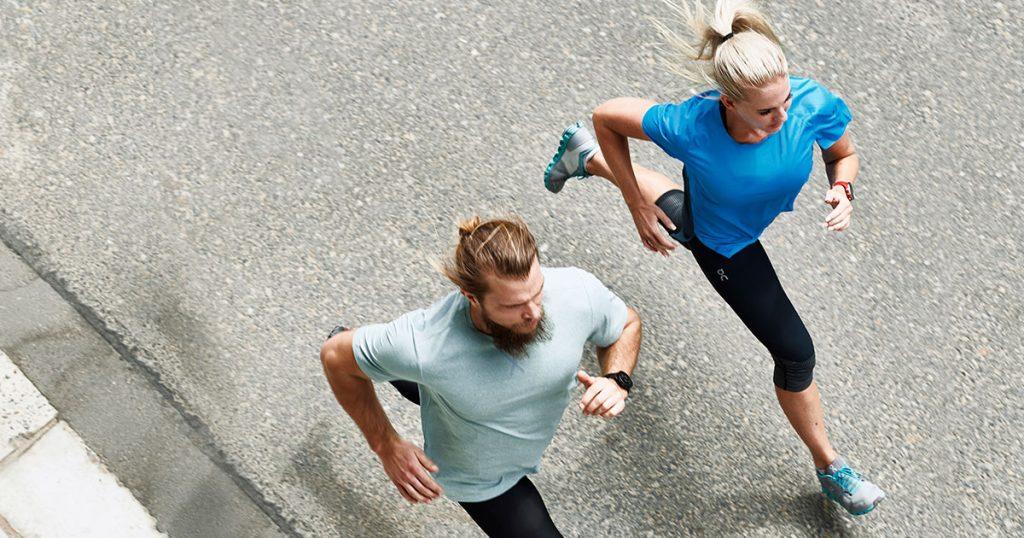
Want To Get Into Running? Here’s A Checklist Of Everything You Need Woman running alongside her best friend. Starting a running routine can be a great way to improve your physical and mental health. Before you hit the pavement, it’s important to make sure you have everything you need to stay safe and comfortable during your workouts. Here is a checklist of items to consider when starting your running routine: Running shoes: Investing in a good pair of running shoes is essential to prevent injury and provide the proper support for your feet. Look for shoes that are comfortable, have good arch support, and are designed for running. Comfortable clothing: Wearing comfortable, moisture-wicking clothing can help you stay cool and dry during your workouts. Look for clothes made from breathable fabrics, such as cotton or polyester, and avoid clothing that is too tight or restrictive. Socks: Socks are often overlooked, but they play an important role in keeping your feet comfortable and preventing blisters. Look for socks made from moisture-wicking materials and avoid cotton socks, which can retain moisture and lead to blisters. Water bottle: Staying hydrated is crucial when running, especially during hot weather. Bring a water bottle with you on your runs and make sure to drink water before, during, and after your workouts. Sunscreen: Protecting your skin from the sun’s harmful rays is important, even on cloudy days. Apply sunscreen with at least SPF 30 to exposed skin before heading out for your run. Hat or sunglasses: Wearing a hat or sunglasses can help protect your face and eyes from the sun’s rays and prevent squinting, which can cause headaches. Reflective gear: If you plan to run in low-light conditions, such as at dawn or dusk, it’s important to wear reflective gear to increase your visibility to drivers and cyclists. Phone or GPS watch: Using a phone or GPS watch can help you track your distance, pace, and progress during your runs. It can also be a safety tool in case of an emergency. ID bracelet or card: Carrying an ID bracelet or card with your name, emergency contact information, and any medical conditions can be helpful in case of an emergency. Music or podcasts: Listening to music or podcasts can make your runs more enjoyable and help you stay motivated. Consider creating a playlist of your favorite songs or finding a podcast that interests you. By following this checklist, you can ensure that you have everything you need to start your running routine on the right foot. Remember to start slow and gradually increase your distance and intensity to prevent injury and enjoy the benefits of running for years to come.
15 Exercises You Can Do At Home With No Equipment
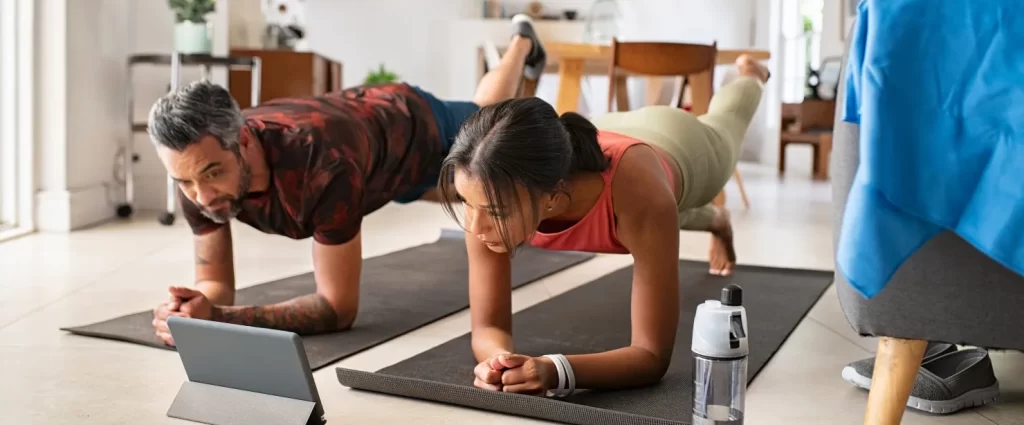
15 Exercises You Can Do At Home With No Equipment Daughter and father exercising. Exercising at home with no equipment is an excellent way to stay active and improve your health and fitness. You don’t need expensive gym memberships or fancy equipment to get a great workout. Here are 15 exercises you can do at home with no equipment: Push-ups – Push-ups are a classic bodyweight exercise that work your chest, triceps, and shoulders. Start with a few sets of 10-15 reps and work your way up to more challenging variations. Squats – Squats are a great lower body exercise that work your glutes, quads, and hamstrings. Stand with your feet shoulder-width apart, bend your knees, and lower your hips towards the ground. Keep your chest up and your weight in your heels. Lunges – Lunges are another great lower body exercise that work your glutes, quads, and hamstrings. Step forward with one foot and bend your knee until your thigh is parallel to the ground. Repeat on the other side. Plank – Planks are an excellent core exercise that work your abs, lower back, and hips. Hold a straight-arm plank for 30-60 seconds, keeping your body in a straight line from head to heels. Mountain climbers – Mountain climbers are a dynamic exercise that work your core, shoulders, and legs. Start in a push-up position and bring one knee towards your chest. Switch legs quickly and repeat. Burpees – Burpees are a full-body exercise that work your legs, core, and upper body. Start in a standing position, drop into a squat, kick your feet back into a push-up position, do a push-up, jump your feet back to your hands, and jump up explosively. Jumping jacks – Jumping jacks are a great way to get your heart rate up and work your legs and shoulders. Start with your feet together and arms at your sides. Jump your feet out and raise your arms overhead. Jump back to the starting position. High knees – High knees are a cardio exercise that work your legs and core. Run in place and bring your knees up to hip height. Butt kicks – Butt kicks are another cardio exercise that work your legs and core. Run in place and kick your heels towards your butt. Tricep dips – Tricep dips work the backs of your arms. Sit on the edge of a chair or bench and place your hands behind you. Lower your hips towards the ground and push back up. Wall sits – Wall sits are a great lower body exercise that work your quads and glutes. Lean against a wall and lower your body until your thighs are parallel to the ground. Bicycle crunches – Bicycle crunches work your abs and obliques. Lie on your back and bring your knees towards your chest. Alternate bringing your left elbow to your right knee and your right elbow to your left knee. Superman – Superman is a great exercise for your lower back. Lie on your stomach and lift your arms and legs off the ground. Calf raises – Calf raises work your calf muscles. Stand with your feet shoulder-width apart and raise your heels off the ground. Lower back down. Side planks – Side planks work your obliques and core. Lie on your side and prop yourself up on your elbow. Raise your hips off the ground and hold. In conclusion, there are many exercises you can do at home with no equipment. By incorporating a few of these exercises into your daily routine, you can improve your fitness, strength, and overall health.
9 Non-dairy Foods That Are High In Calcium
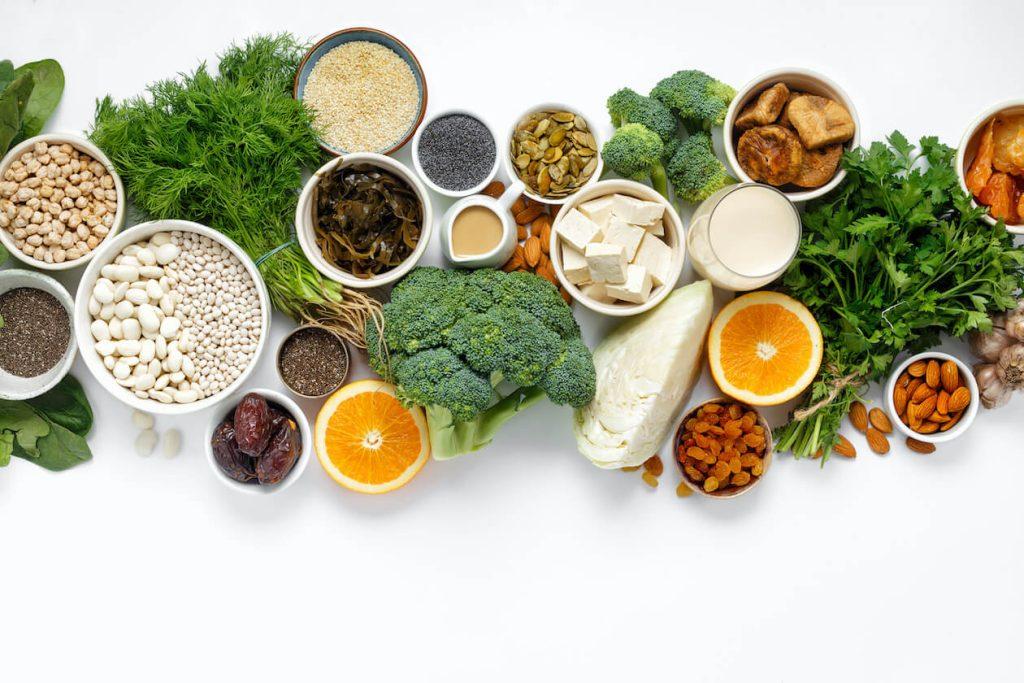
9 Non-Diary Foods That Are High In Calcium Foods high in calcium. Calcium is an essential nutrient that plays a crucial role in maintaining healthy bones and teeth, as well as supporting other bodily functions like nerve transmission and muscle contraction. While dairy products are a common source of calcium, there are many non-dairy foods that are high in calcium as well. Here are nine non-dairy foods that are high in calcium: Leafy Greens – Leafy greens like kale, collard greens, and spinach are rich in calcium, with around 100-250 milligrams of calcium per cup of cooked greens. These greens are also high in other important nutrients like vitamin K and iron. Tofu – Tofu is a versatile soy-based food that is high in calcium, with around 434 milligrams of calcium per half-cup of firm tofu. It is also a good source of protein and other nutrients. Canned fish – Canned fish like salmon and sardines are a good source of calcium, with around 180-210 milligrams of calcium per 3-ounce serving. They are also a good source of omega-3 fatty acids and other nutrients. Almonds – Almonds are a type of nut that are high in calcium, with around 76 milligrams of calcium per ounce. They are also a good source of healthy fats and other nutrients. Fortified Foods – Many foods are fortified with calcium, including some types of plant-based milk, orange juice, and cereal. These foods can be a convenient way to get more calcium in your diet, with around 200-300 milligrams of calcium per serving. Chia seeds – Chia seeds are a type of seed that are high in calcium, with around 179 milligrams of calcium per ounce. They are also a good source of fiber and other nutrients. Beans – Beans like navy beans, black beans, and pinto beans are a good source of calcium, with around 90-115 milligrams of calcium per half-cup serving. They are also a good source of protein and other nutrients. Broccoli – Broccoli is a type of vegetable that is high in calcium, with around 43 milligrams of calcium per half-cup serving. It is also a good source of other important nutrients like vitamin C and fiber. Sesame seeds – Sesame seeds are a type of seed that are high in calcium, with around 280 milligrams of calcium per ounce. They are also a good source of healthy fats and other nutrients. In conclusion, while dairy products are a common source of calcium, there are many non-dairy foods that are high in calcium as well. By incorporating some of these foods into your diet, you can boost your calcium intake and enjoy a variety of nutritious foods.
10 Surprising Sources Of Protein
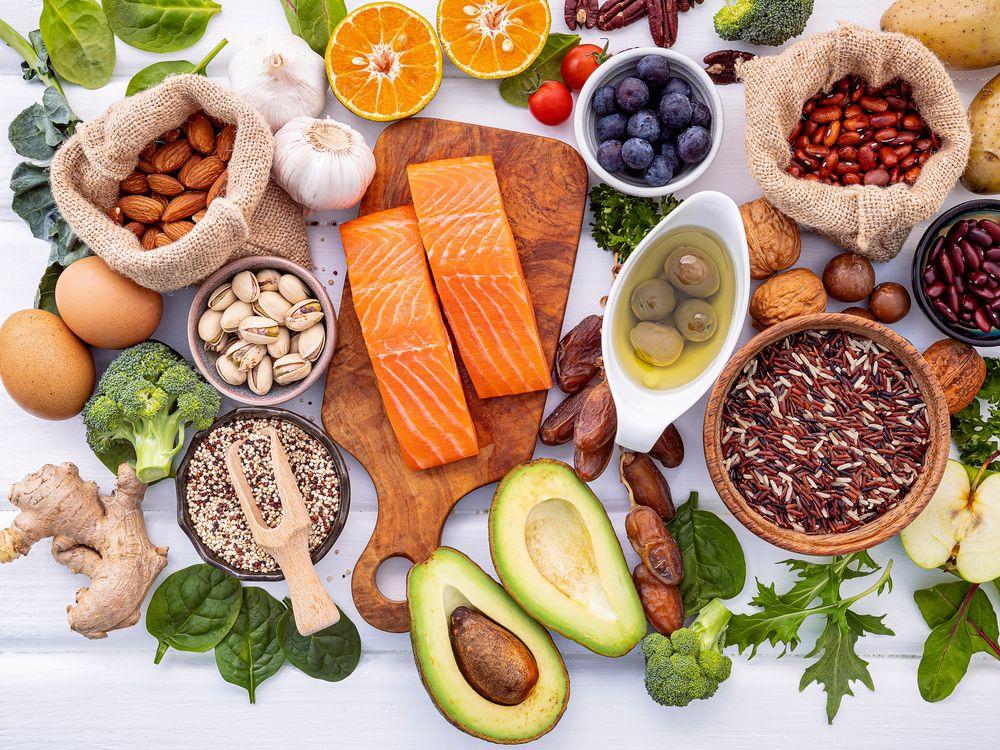
10 Surprising Sources Of Protein High foods in protein scattered on a table Protein is an essential nutrient that plays a crucial role in building and repairing tissues, as well as maintaining overall health. While many people rely on animal-based protein sources like meat, poultry, and fish, there are many surprising sources of protein that you may not have considered. Here are 10 surprising sources of protein: Lentils – Lentils are a type of legume that are high in protein, with around 18 grams of protein per cooked cup. They are also a good source of fiber, iron, and other nutrients. Edamame – Edamame are immature soybeans that are typically served steamed or boiled. They are a great source of plant-based protein, with around 17 grams of protein per cup. Quinoa – Quinoa is a versatile grain that is gluten-free and high in protein, with around 8 grams of protein per cooked cup. It is also a good source of fiber, iron, and other nutrients. Cottage cheese – Cottage cheese is a type of cheese that is low in fat and high in protein, with around 28 grams of protein per cup. It is also a good source of calcium and other nutrients. Greek yogurt – Greek yogurt is a thicker, creamier version of regular yogurt that is high in protein, with around 23 grams of protein per cup. It is also a good source of calcium and other nutrients. Hemp seeds – Hemp seeds are a type of seed that are high in protein and healthy fats, with around 10 grams of protein per 3 tablespoons. They are also a good source of fiber and other nutrients. Seitan – Seitan is a meat substitute made from wheat gluten that is high in protein, with around 25 grams of protein per 3.5 ounces. It is also a good source of iron and other nutrients. Peanut butter – Peanut butter is a popular spread that is high in protein, with around 8 grams of protein per 2 tablespoons. It is also a good source of healthy fats and other nutrients. Spirulina – Spirulina is a type of blue-green algae that is high in protein, with around 4 grams of protein per tablespoon. It is also a good source of other nutrients like iron, calcium, and vitamins. Pumpkin seeds – Pumpkin seeds are a type of seed that are high in protein and healthy fats, with around 5 grams of protein per ounce. They are also a good source of fiber, iron, and other nutrients. In conclusion, while animal-based protein sources are often the go-to for many people, there are many surprising sources of protein available. By incorporating some of these plant-based sources into your diet, you can boost your protein intake and enjoy a variety of nutritious foods.
How Much Protein Do You Actually Need
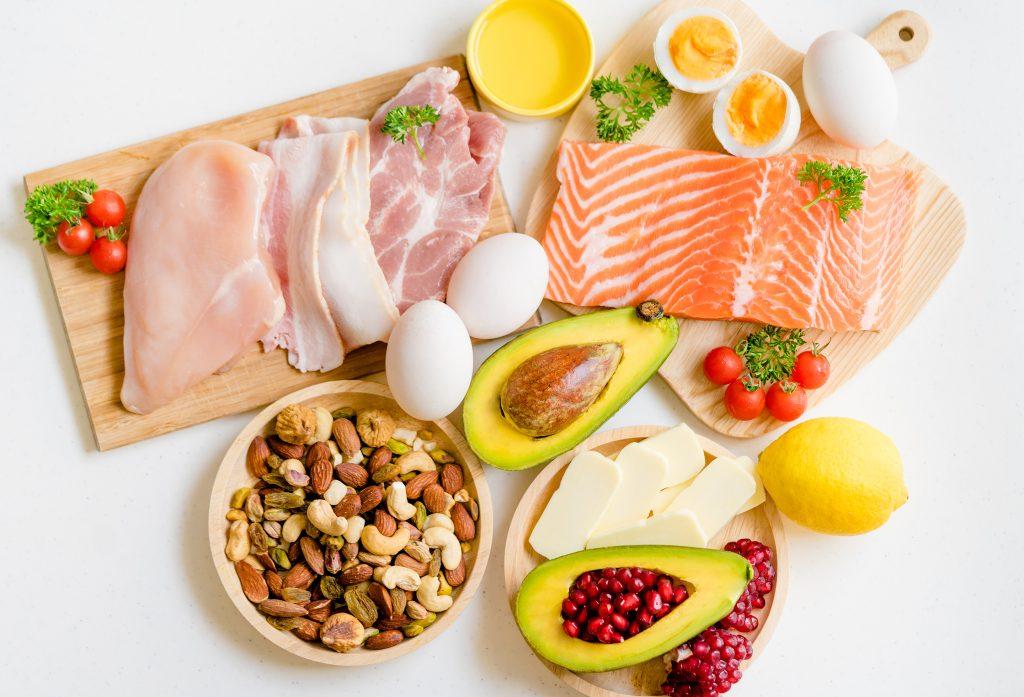
How Much Protein Do You Actually Need Delicious foods that contain protein It’s an age-old question: how much protein do you need for maintaining good health or just building muscle? The answer to this question still varies and continues to be confusing to this day. Having protein in our bodies is a very important part of keeping healthy and alive, along with fats and carbohydrates. To eat enough protein at least every day should be thought about frequently, but how much of it do we need in our bodies? To understand this question people must know what the function of protein is in our lives, the intake of it in our systems, and why we need enough of it. To understand how much protein people need, one must understand the function of protein in the human body. Protein is a nutrient that is found throughout the body; in the muscle-bound, skin, hair, tissues, etc. It plays an important role in the creation and maintenance of the cells in the human body. Fueling our cells and powering our bodies, we need protein in our everyday meals. There are many reasons as to why we need protein in our lives. For example, protein is required for the prolongation and development of the tissues in our bodies. Our bodies protein needs are dependent on our health and activity level. They also fight infections because it Strengthen the immune system and is essential for maintaining body functions such as circulation. Moreover, knowing why we need protein in our lives gives a clearer understanding of how much of it we should be digesting each day. People must understand the daily intake of protein to understand how much or too little of it were consuming. When it comes to protein, everyone requires a different amount based on factors such as the weight, physical activity, muscles mass and more. Ideally 10 to 30% of your total calories should come from protein, whereas 45-65% from carbs, and 25-35% from fats. Consuming at least 10-30% of your daily calories from protein should provide your body enough amino acids to keep the body functioning well (livestrong.com). According to The Mayo Health Clinic, the recommended dietary allowance of protein for a somewhat inactive adult is about .8 grams. For example, a person who weighs 150 pounds should consume about 55 grams of protein per day. Furthermore, as you continue to age and become more inactive, to maintain quality of life, one should increase their protein intake by about 1-1.2 grams. To meet dietary protein needs people should spread out protein consumption evenly throughout each day. People can also choose from the healthiest protein sources to eat out of which includes; nuts,beans,lentils, eggs, chickens, and varieties of fishes. Overall, proteins are macronutrients that are vital to the function of the human body on almost every level. It’s important for tissue growth and repair, hormone production, and a healthy immune system. Protein can be found in many foods, and a balanced diet can provide all necessary amino acids (molecules that combine to form proteins) for our bodies. The amount of protein we take should be around .8 grams and for people who exercise regularly it should increase by about 1.1-1.5 grams per kg. To meet any of these needs people must also make sure they should have these proteins during every meal of the day for breakfast, lunch, and dinner. It is therefore good to consume lots of proteins.
